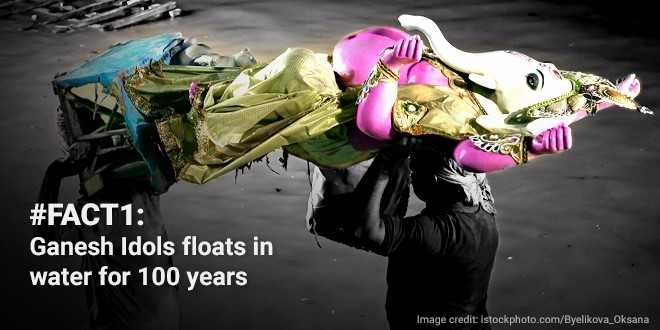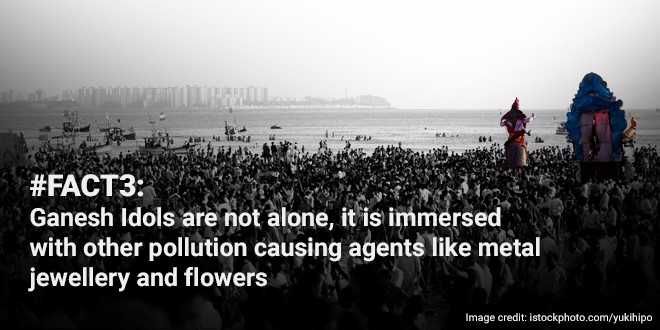Highlights
- Ganesh Chaturthi will be celebrated from August 25 to September 5
- Idols made of Plaster Of Paris pose huge risk to the environment
- Eco-friendly idols available to cut down on the damage caused by visarjan
Ganpati bappa morya, agle baras tu jaldi aa! The air resonates with these cries once every year, the literal meaning being Ganesha, my lord, come back soon next year. And so year after year the tradition of welcoming the Elephant-headed God into the homes on Ganesh Chaturthi, followed by the send off 10 days later with the Visarjan or immersion of the Ganesha idols continues. The festival is celebrated with great fervour in many part of the country. The processions with the Ganesha idols, as he makes his way for the immersion are colourful affairs, with music, dancing and the atmosphere is charged with chants of the followers, as the countless idols makes their way through various streets across the country into different water bodies. Symbolic of nothing is permanent in this mortal world, the visarjan though leaves behind a lasting impact on the water bodies where the idols are immersed.
With each passing season, the adverse environmental effects of idol immersion on water bodies and the ecology of surrounding areas are worsening at an alarming rate. This year is not likely to be different. Here’s how idol immersion damages the environment.

Piles of ganesh idols along the beaches or rivers of India is a common sight during this time of the year
Idols Can Pollute The Water Bodies And Have An Impact For 100 of Years:
Ganesha idols are generally made up of Plaster of Paris (POP), plastic and cement. Then these are decorated with paints (which are toxic), heavy decorations and flowers. In short, once the immersion takes place, the statue of gods along with other toxic things live on for decades in water and travel from one water body to another, leaving an indelible impact on the ecosystem.
Plaster of Paris contains calcium sulfate hemihydrate, which can take several years to fully dissolve. It also reduce oxygen levels in the water, kills the fishes and other aquatic animals. The end result is huge amount of water pollution which then gets mixed with other types of waste, thereby poisoning our water sources for several and several years.
The More Colurful The Idol Is, The More Harm It Will Cause
Ganesh idols are often decorated with toxic paints which contains heavy metals such as lead and mercury which seeps into the water after the idol immersion, and adds to the acidic level of water which is not good for the environment and marine life. It can also cause skin diseases in humans.
Ganesha Is Not Alone, It Is Immersed With Other Pollution Causing Materials
Decked up with heavy metal jewellery, decorations and hundreds of flowers, when the ganesh idols are immersed in the water bodies, all this waste ends up in water bodies. Although flower waste is usually bio-degradable, but, since these are cultivated using many fertilizers and pesticides, when it mixes with water these pollution causing agents remain as residue on the flower, and pollutes the water body and affect their fragile ecosystem.
What Needs To Be Done?
Making a greener choice when selecting idols, is one option. There are many alternatives available today that are non-polluting and bio-degradable. The other option is to take the pressure off the traditional water bodies that are reeling under the daily discharge of sewage, industrial effluents, plastic and other waste which is being dumped into the water untreated. Idol immersion only adds to this burden. So, making alternative tanks for immersion or similar arrangements at individual household level may take this additional pressure off our dying water bodies.
Also Read: Eco-Friendly Ganesh Chaturthi: Ganapati Idols That Grow Into Plants After Immersion
































Sagar
August 26, 2017 at 6:45 pm
Would you care enough to explain the consequences of other festivals in India. Say for example-Bakri-Eid. I would be happy to know about the consequences on the environment.
Ganesh Deo
August 28, 2017 at 12:11 am
please also write article with equal enthusiasm about pollution caused by: new year celebrations, EID etc.
Vikranth
August 28, 2017 at 7:04 am
A commendable article addressing and providing plausible solutions to a problem that needs immediate attention. Hope the Central and State Governments with the respective ministries in collaboration with the right NGOs, civil society and celebrities push for bio-degradable Ganesha idols by next year. Hope some of the Intellectuals and the restless youth in some of our college campuses direct their energies by taking up this issue. And then we can perhaps move towards addressing the problem Industrial wastage with toxic chemicals being constantly dumped into the water bodies, perhaps through proper recycling plants etc.
We are an emotional people. So what better way of bringing to the notice of the generally lackadaisical public about the toxic chemicals polluting our water bodies, than God himself! May Vinayaka (the lord of removing obstacles) himself clear the obstacles and delays in getting this righteous work done.
Om Gam Ganapathaye Namah
Pooja Verma
February 14, 2019 at 7:54 pm
Apart from using ecofriendly Ganpati Idols, we should also educate and encourage people to use non-painted version of idols as paints used on these idols are mostly synthetic and are quite dangerous for rivers. We have a clay studio in Noida Claying Thoughts and have been making Ganesha Idols for couple of years only on order. Unfortunately, very few people agrees to buy non painted idols. Rest everyone wants beautiful handpainted idols with gloss. This year we are shall only by taking orders for non painted idols with haldi and red tilak on forehead.
SINGURU RAJESH
July 8, 2020 at 1:57 pm
We Green Gears (Gearing up for Green Club of Students from Raghu engineering college, Visakhapatnam) are sharing you a sustainable solution for stubble burning by farmers and POP Ganesh Idols that harm ecosystem may help many others to think towards sustainable solutions.
We transformed the stubble & agro-residues that are burning by farmers in the fields into GREEN GEARS GANESHA Idol, which can be Nimarjan in land and water without harming the environment. As these are the stubble Ganesh Idols these won’t harm ecosystem. If we keep the GREEN GEARS GANESHA Idol in soil (i.e. buried in soil) it gets decomposed. These Idols can be made by local farmers and sell in market such that financial empowerment of farmers can be achieved and they won`t burn stubble in the farm fields. Some special features are there with us GREEN GEARS GANESHA Idol. We added some herbal plant seeds in this Ganesh Idol while moulding, which helps in generating a plant after it goes into nimarjan in soil (i.e. buried in soil). If this Ganesh Idol do Nimarjan in water bodies it make some algae and provide food for the aquatic animals.